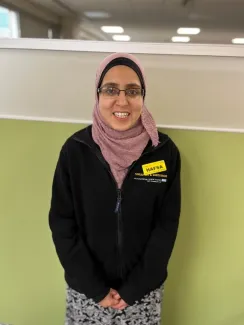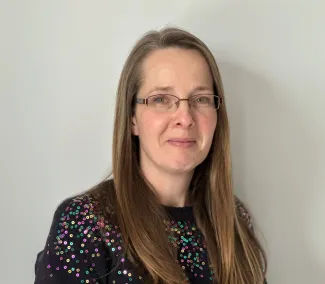George was wonderful. Even at three years old, he had incredible speech and an ability to articulate himself well. George was also very aware of those around him and watched carefully to pick up cues of changing emotions. He’d say: “Are you happy mummy?” while looking deep into my eyes. He had empathy that we didn’t know a child so young could possess. He saw others’ changing emotions and responded. If other children were sad, his face would change, and he’d feel some of that emotion with them.
When George was diagnosed, we were whisked into hospital life. We were grateful that we could communicate well with him and explain things to him, in an age-appropriate way. George was always satisfied if we explained what was coming and why it was happening. He was so watchful of our emotions that with this communication came the need for calm, confidence and positivity in our delivery. If we were happy with what was happening, he was satisfied.
Using clear and consistent language helped us
When you first arrive in hospital, people don’t know you or your child. We were George’s advocates and had to help medical professionals get to know him, quickly. We requested that conversations didn’t happen across the bed, as if George wasn’t there. We hated the thought that he may take some of what was being said and jumble it together to create his own unclear understanding. We had our narrative for his cancer and wanted to use consistent language with him to help him understand, as clearly as possible, without fear or confusion.
George’s ‘naughty’ cells didn’t know what their job was, and they ended up coming together in a naughty lump. He knew he had good cells that needed to be strong to help fight those naughty cells better. Chemotherapy was his 'strong' medicine to ‘power up’ his good cells. This was then 'special' medicine during his maintenance treatment and 'super' medicine after relapse. In time, medical professionals got to know our narrative and used this to support George and provide consistent and clear communication for him. Giving patients such a personalised approach is difficult in a busy hospital, but as parents using our consistent language with the medical team, sharing our narrative loudly, it allowed staff to pick up on it and use it as well.
Medical staff giving children time to communicate is important. The morning of major surgery to his head, to remove the tumour, the neurosurgeon asked George if he had any questions. George asked how many naughty cells were in his lump. Taken aback by the question, the neurosurgeon said he’d let George know. In recovery, with his head wrapped in bandages, George continued to return to his question until the neurosurgeon returned with an answer. Curiosity satisfied, he could get on and play. Taking the time to see if our three-year-old had any questions and then later providing him with an answer, demonstrated the shared value of communication between medical professionals, the young patient and his parents.
Staying in the present
George brought us joy even in the most challenging of times with his kindness and joy. We stayed really present and in the moment with him, focusing on the now, which meant every difficult procedure or tough moment passed, and a new adventure could begin.
One day sticks in my mind, when the nurse couldn’t place George’s nasogastric tube. In that moment, he was cross and shouting, not wanting the nurse to try again.
David held George in a firm cuddle as I continued to be calm, confident and positive, reassuring him that in seconds it would be over, with messy play waiting for him.
After many attempts, the tube was placed successfully and cuddles comforted and helped return the adrenaline to more normal levels. The ‘brave box’ appeared, and George chose a toy and smiled. Back at his hospital bed, we settled George to some messy play, as promised. He looked up at his daddy and said: “Sorry for shouting at you, Daddy.” We both swallowed hard and told him how much we loved him. In that moment, George, despite his age, demonstrated a true understanding of how hard the difficult situation had been for his daddy, too.
Another challenge was when, because of lock jaw as a result of lost muscle during surgery, a breathing tube would have to access his airway via a tracheostomy. We could share what was going to happen and why he needed it, but we couldn’t be sure how much oxygen he’d be able to get to his vocal cords. We couldn’t be sure if he’d wake up with a voice.
This was one of our hardest days. We couldn’t communicate this clearly for him and had no idea if he’d be able to use his superpowers – his beautiful speech, and ability to articulate himself and ask curious questions.
George woke with no voice, banging at his bed, pointing at his mouth, with tears rolling down his cheeks. We quickly developed non-verbal methods of communication, such as thumbs up and down and basic sign language, but it was far too simple for our curious boy. Fortunately, our superstar learnt how to push the oxygen up to his vocal cords by lunchtime and, despite the added complication of the locked jaw, continued to show strength in his communication throughout his hospital stays.

David, Lisa and George
Maintaining our approach after George’s relapse
George relapsed when he was four. The rhabdomyosarcoma returned and spread. He could see his face had changed, as the tumour grew behind his eye and into his cheek. He could taste dry blood as the tumour pushed its way into his mouth. George remained calm, guided by our energy and approach. We continued to communicate what was coming and why. We listened to him and allowed him to make choices and take control of his surroundings and activities. Communication was key.
Our verbal communication was clear and emphasised trust in his palliative care team, while our non-verbal communication demonstrated calm and joy in the moments that offered it. George never knew he was dying or that his good cells couldn’t keep fighting the naughty cells. He trusted that if we were happy, he was safe.
Everyday continued to be a new day with something fun to do or learn no matter how tired he got or how much drugs he’d been given. He wanted to know what a two-humped camel was called, days before he passed away. One of the last conversations George had with his daddy, as they peered into a cup together looking at a caught spider, was pondering why it only had seven legs.
A final message
To finish what I hope has been a story highlighting the importance of clear communication, I must add how exhausting this was. Advocating for your child 24/7, gathering your thoughts and preparing your narrative, before then sharing with your child, takes brain power and energy from parents who are already ‘full’. It’s important that parents find time to communicate with someone, ask questions and share how they’re feeling, to release a little of that ‘fullness’ and be able to keep giving what their children need.
Parents and medical teams, together, should plan time for communication where parents are heard and through which patients are truly seen. The result would be parents better able to be the best they can be for their child and medical teams better equipped to offer the best they can for their patients.
From Contact magazine issue 106 | Spring 2025




